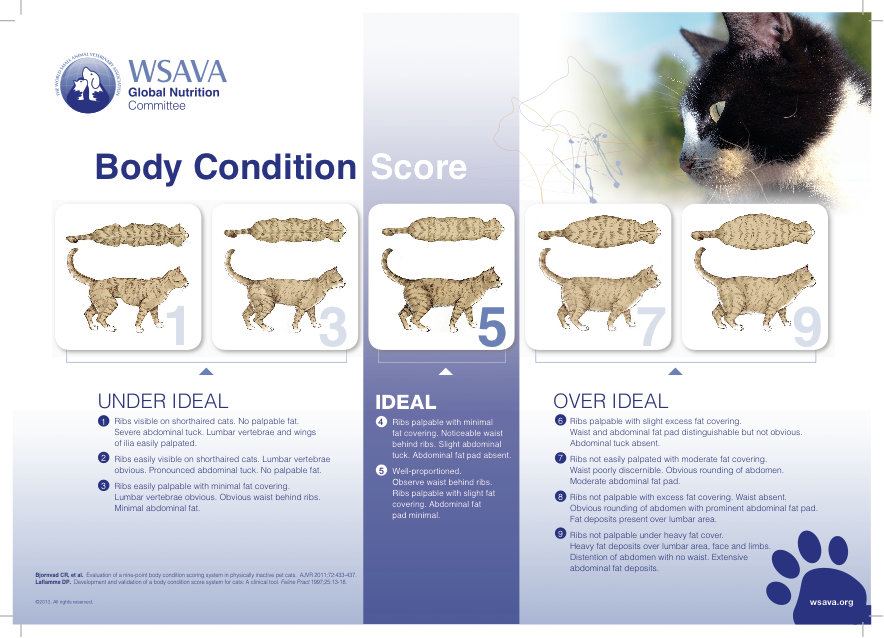You are here
Pet Obesity

How to Help Your Cat Lose Weight
Does your cat need to lose weight? It’s very important that you keep a close eye on weight fluctuations in your cat. It’s one of the key indicators of your cat's overall health. As little as two pounds above your cat’s ideal weight can put it at risk for developing some serious medical conditions. Unfortunately, when a cat is overweight or has obesity it is at great risk for developing a secondary condition such as diabetes.
Understanding the Risks. How to Help Your Cat Lose Weight to Avoid Diabetes
Diabetes mellitus, commonly referred to as diabetes, is a serious condition that affects a growing number of people every year, but many don’t realize that the number of cats with diabetes is also on the rise. In fact, many of the medications, equipment, and monitoring systems are the same for pets and people. Diabetes occurs when a human or animal’s pancreas is unable to produce enough insulin to safely absorb the glucose in foods for use in the body. Diabetes in commonly found in cats with obesity being a contributing factor.
Diabetes exists in three forms:
- Type 1 – the pancreas is not producing insulin
- Type 2 – the pancreas is producing insufficient insulin or the insulin being produced is ineffective
- Type 3 – hormone-induced, insulin resistance develops in association with high concentrations of progesterone
Type 2 diabetes is the most common in cats.
Cat Diabetes Symptoms
The symptoms of diabetes can easily be confused for other conditions. If you recognize a combination of any of the symptoms listed below, contact your veterinarian immediately for proper testing.
- increased thirst
- increased urination
- increased appetite with stable weight or weight loss
- thinning, dry, or dull hair
Diagnosing Diabetes in Your Cat
To ensure an accurate diagnosis, your veterinarian will collect blood and urine from your cat to check for elevated glucose and the presence of ketones. Cats are particularly prone to having high glucose in their blood during stress, such as the stress of having their blood taken. For this reason cats usually require an additional test to measure fructosamine in their blood. Excessive glucose and/or fructosamine levels in a pet’s blood and urine indicate insufficient insulin production and confirm the diagnosis of diabetes.
Complications of Diabetes in Cats
If a diabetic pet is not properly cared for a number of complications can arise. An excess of glucose in the blood can cause a diabetic coma, while insufficient levels of glucose can lead to diabetic seizure, both of which require emergency medical attention. In cats, weakness of the hind legs (diabetic neuropathy) is a common complication of uncontrolled diabetes.
Management of Cat Diabetes
life expectancy. Depending on which type of diabetes your cat has, your veterinarian will prescribe daily insulin injections to regulate your pet’s blood sugars. Along with regular injections and veterinary check-ups, daily exercise and a controlled diet are essential to regulating your pet’s blood sugars.
If you suspect your cat may be at risk for developing diabetes or if you’d like to keep your diabetic cat’s blood sugars more consistent, consult with your veterinarian. In addition to providing diagnosis and treatment, your veterinarian can advise you on lifestyle changes to improve your cat’s overall health quality of life.
Additional Diseases Caused by Cat Obesity
On your cat’s next visit to the veterinarian, it’s important that the veterinary team look at your cat for the following signs that are often a cause of your cat being overweight:
- Kidney disease
- Chronic inflammation
- Heart disease
- Osteoarthritis
- High blood pressure
- Many forms of cancer – especially intra-abdominal cancers
How to Help Your Cat Shed Unhealthy Weight
If you and your veterinarian have established that indeed your cat is overweight and not simply fluffy, you will want to explore some strategies for your cat to lose the pounds they need to get to a healthy weight. Some experts suggest switching your cat’s dry food or kibbles with canned food. This will allow them to not only get more protein in their diet but also have fixed meals instead of snacking throughout the day. Canned food has the additional benefit of ensuring cats get enough fluid. In addition to a low-calorie diet, make sure to incorporate more activity in your pet’s day-to-day life. Reward your cat with playtime or toys, rather than treats, to cut down on excessive calories.
Lastly, don’t starve your cat as this may lead to life-threatening liver disease (Fatty Liver Syndrome) in felines.
Your Veterinarian is Your Cat’s Best Friend
If your cat is overweight, your veterinarian and veterinary technologist are your best resource for helping your cat. Book an appointment for your cat with your veterVet Team so both you and your cat can enjoy greater peace of mind.
Further Reading:
Fluffy or Fat?
How can you tell the difference between fluff and fat? It’s not always as easy as it looks, unless you know exactly what to look for. The World Small Animal Veterinary Association and the Alberta Ministry of Agriculture and Forestry have developed these diagrams to help pet and horse owners evaluate the health of their animals. These diagrams serve as a relative reference only and should not be taken as an indication of your animal’s overall health. If you have any concerns about your animal’s weight or health, consult with your veterinarian for a comprehensive and reliable evaluation.



These diagrams were supplied with courtesy by the World Small Animal Veterinary Association and the Alberta Ministry of Agriculture and Forestry.
| Attachment | Size |
|---|---|
| 219.25 KB | |
| 1.55 MB | |
| 1.3 MB |
